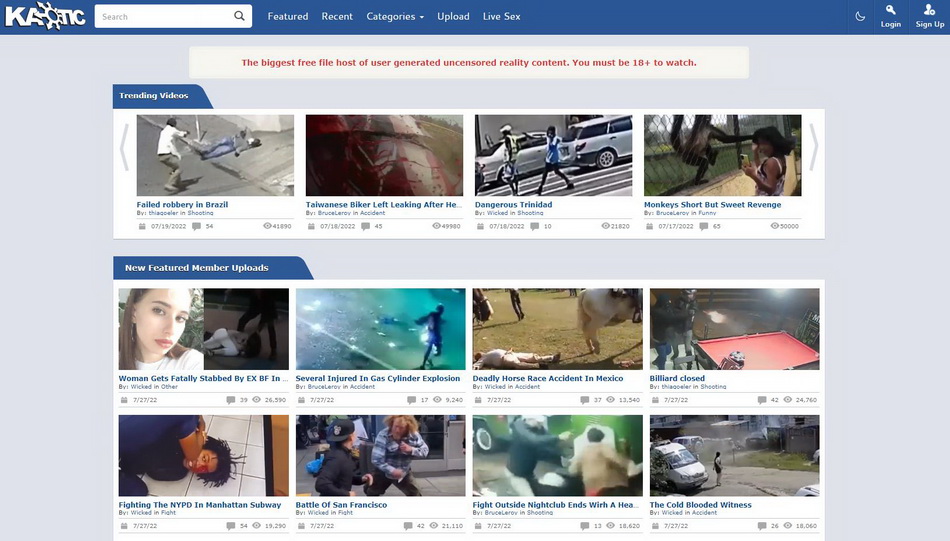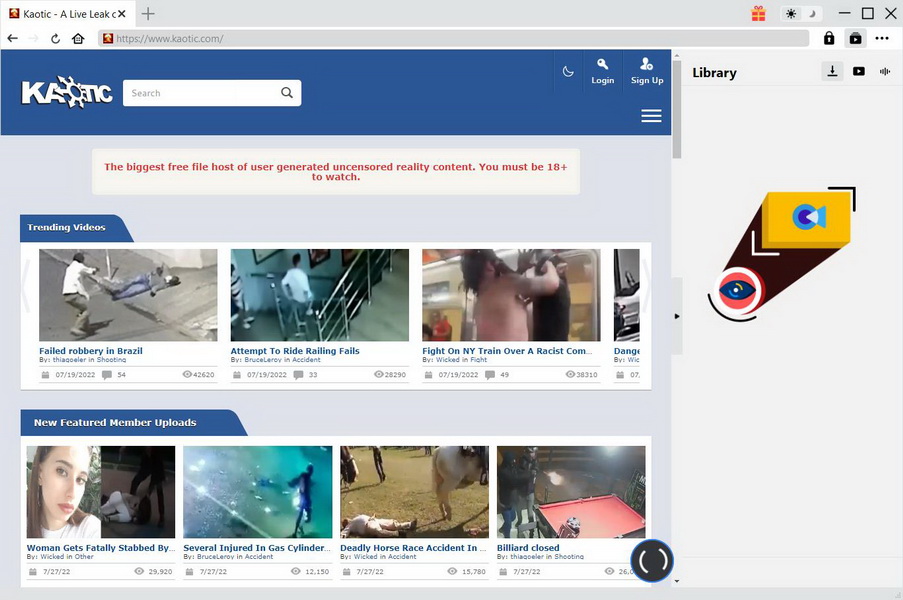[Breaking] Liveleak's Legacy: Exploring The Dark Side Of Gore & Violence
Do you dare to confront the raw, unfiltered reality of a world often shielded from our eyes? Prepare yourself, because the digital realm once offered a space, a dark corner of the internet, where the taboo was embraced, where the unthinkable was documented, and where the very definition of "viewer discretion advised" was stretched to its absolute limit.
The digital landscape, a vast and ever-evolving universe, has always harbored pockets of the unconventional, the extreme, and the utterly shocking. Within this landscape, certain websites emerged, carving out a niche by showcasing content that mainstream platforms steadfastly refused to touch. These were the domains of the visceral, the graphic, the often disturbing havens for those who sought a glimpse into the darkest corners of human experience, or perhaps, a morbid fascination with the boundaries of life and death. One such platform, a name synonymous with the unsettling, was Liveleak. After fifteen years of operation, a platform that, for better or worse, served as a digital mirror reflecting the world's most brutal realities, has closed its doors, leaving a void for some and a sigh of relief for others.
This is a story of the websites that thrived on the fringe, the nature of their existence, and the impact they had on our understanding of online content and societal boundaries. It is a story that takes us into the world of graphic content, the dark side of the internet, and the individuals who navigated this uncharted territory.
| Category | Details |
|---|---|
| Website Name (Former) | Liveleak |
| Primary Content | Violence, Gory Footage, True Crime, Real-life events |
| Founder | Hayden Hewitt |
| Launch Year | 2006 |
| Key Features | Unfiltered news, graphic content, user-generated videos, coverage of events from around the world |
| Closure Date | (Exact date unknown, but closed after 15 years of operation) |
| Associated Sites | Ogrish, Rotten.com, Vile Videos, Livegore, Kaotic, Deep Gore Tube, Abruptchaos community |
| Audience | Adults (18+), those interested in news and real-life events, individuals with a fascination for graphic content |
| Purpose | To provide a platform for sharing and viewing videos that mainstream media outlets would not touch, reporting on real-life events |
| Ethical Considerations | Content often involved violence, graphic imagery, and potentially disturbing events. The platforms raised questions about freedom of speech, the depiction of violence, and the impact on viewers. |
| Controversies | Distribution of violent content, potentially violating terms of service of internet providers, and the effect on psychological health |
| Reference | Wired Article on Liveleak |
Liveleak was more than just a website; it was a phenomenon. Born in 2006, it emerged from the shadows of the early internet, an offshoot of the infamous shock site Ogrish. Ogrish, along with platforms like Rotten.com, had already established a precedent for pushing the boundaries of online content, offering a glimpse into the often-unseen realities of the world, albeit through a distorted, often gruesome, lens. Liveleak inherited this legacy, becoming a digital sanctuary for content that mainstream platforms deemed too graphic, too violent, or simply too controversial.
The platform's mission, as articulated by its founder Hayden Hewitt, was to offer "unfiltered reality." This meant showcasing videos that documented true crime, acts of violence, war, and other real-life events from around the globe. The content was often raw, unedited, and explicitly graphic. It wasnt designed to be pretty or palatable; it was designed to shock, to provoke, and to expose viewers to a side of the world often hidden from the mainstream media. This type of content was also present on other sites, such as Livegore, which presented itself as a reality news platform reporting on events of public interest, and Kaotic, with its blunt tagline, "Real death videos taken from around the world."
The appeal of such platforms is complex. For some, it was a morbid curiosity, a desire to witness events that are typically shielded from public view. For others, it was a fascination with the darker aspects of human nature, a way to confront the realities of violence and death. It could also be a way to stay informed about current events, albeit through a highly sensationalized lens. And then, of course, there were those who were drawn to the forbidden, the transgressive nature of the content itself.
Access to these sites was, almost universally, restricted to adults. Livegore explicitly stated that access was for those aged 18 and over, and the "viewer discretion is strongly advised" message was a constant. Vile Videos promised to showcase events and scenarios "you won't find anywhere else," with the implicit understanding that what was offered was not for the faint of heart. Deep Gore Tube, for example, made no attempts to sugarcoat its offerings, promising "the most brutal execution videos in the world."
The content itself was diverse, ranging from crime scenes and executions to war footage and acts of terrorism. The "Bull attacks owner in a cowshed" videos, which seemed to be a subgenre, exemplified the unpredictable nature of life and the moments of sudden, violent chaos that sometimes find their way into recorded history. Other sub-communities, like the "abruptchaos" community, with its 2.4 million subscribers, focused on videos that ended suddenly, often hilariously, in moments of pandemonium.
The existence of these sites and the content they hosted inevitably led to controversy. They were often criticized for glorifying violence, desensitizing viewers, and potentially contributing to psychological harm. Questions were raised about the ethical responsibilities of platforms that hosted such content, and the line between freedom of speech and the dissemination of harmful material was constantly debated. The platforms themselves often walked a tightrope, attempting to balance the desire to provide a platform for uncensored content with the need to avoid legal challenges and maintain a degree of social responsibility.
The closure of Liveleak marked the end of an era, a moment to reflect on the legacy of these platforms. They served as a reminder that the internet is a powerful and sometimes dangerous tool, capable of both informing and disturbing. They highlighted the complexities of human nature, our capacity for both creation and destruction, and our enduring fascination with the extremes of life and death. While the specific platforms might fade, the desire to explore the dark side of the internet, and to witness the raw, unfiltered reality of the world, is likely to persist. The digital landscape will undoubtedly continue to evolve, and new platforms will emerge, carrying on the tradition of pushing boundaries, challenging norms, and, ultimately, forcing us to confront the uncomfortable truths that we often prefer to ignore.
The legacy of sites like Liveleak, and the related platforms, is a complex one. They were, in many ways, a mirror reflecting the darker aspects of our world. They were also a testament to the power of the internet to connect people, to disseminate information, and to challenge the status quo. Whether one views their existence as a necessary evil or a dangerous indulgence, there is no doubt that these platforms left an indelible mark on the digital landscape, prompting us to consider the ethical, social, and psychological implications of the content we consume online.
As the digital world continues its relentless evolution, the echoes of these platforms will undoubtedly linger. They serve as a cautionary tale and an enduring reminder of the constant tension between freedom of expression and the need to protect ourselves and others from the darker forces that exist within the digital realm. The question remains: as technology advances, what new forms will these raw expressions of reality take, and how will we, as a society, navigate the ever-blurring lines of acceptable content and the human fascination with the taboo?
The shutdown of Liveleak is not just the removal of a website; it's a punctuation mark in the long and complicated narrative of the internet's relationship with violence and graphic content. It forces us to consider what we gain and what we lose when these virtual windows into the world's underbelly are either opened or closed. It challenges us to continually re-evaluate the delicate balance between censorship, freedom of expression, and the potential for harm in a digital age where information, and images, can spread at an unprecedented pace.
The discussion around websites such as Liveleak also encompasses a broader debate: the impact of readily available graphic content on mental health. Exposure to violent and disturbing imagery can have a profound effect on individuals, potentially leading to increased anxiety, fear, and even symptoms of post-traumatic stress. The normalization of such content raises concerns about desensitization and the potential for an erosion of empathy. This, coupled with the challenges of content moderation and the ever-evolving algorithms of social media, presents a significant set of ethical and social dilemmas that continue to demand careful attention.
The closure of Liveleak might not have been a final chapter, but a transition. The essence of the content these sites represented--the desire to confront the raw, unfiltered reality--will find new outlets. Platforms will emerge, perhaps more subtle, or even more brazen, pushing the boundaries of what's acceptable. The story of sites such as Liveleak is ultimately the story of the human condition itself - the desire to understand, the fascination with the forbidden, and the constant struggle to make sense of a world that is sometimes beautiful, and often brutal. It's a narrative that will, undoubtedly, continue to unfold.
The questions raised by the existence of platforms like Liveleak will continue to haunt us, forcing us to question the ethics of online content, the impact of exposure to violence, and the very nature of truth in the digital age. The closure of such a website is not an ending, but a beginning, the start of a renewed discussion on these topics.



Detail Author:
- Name : Rubie Erdman Sr.
- Username : homenick.kenyatta
- Email : antwan.johnston@kovacek.com
- Birthdate : 1990-11-26
- Address : 8570 Kaylin Lights North Jolieberg, NM 27548-4075
- Phone : (240) 341-7461
- Company : Jenkins LLC
- Job : Private Detective and Investigator
- Bio : Saepe in sed exercitationem qui repudiandae sunt facere. Nisi quis atque non dolores tempore. Optio ipsum odit nihil qui quae deserunt.
Socials
facebook:
- url : https://facebook.com/donnell.harris
- username : donnell.harris
- bio : Odit sit incidunt veritatis magnam eligendi.
- followers : 3518
- following : 1107
twitter:
- url : https://twitter.com/donnellharris
- username : donnellharris
- bio : Soluta ut in illum. Eius totam est blanditiis. Et eos qui voluptatem consequatur.
- followers : 1129
- following : 595